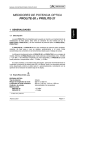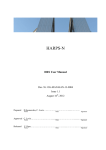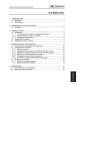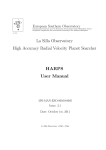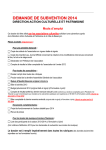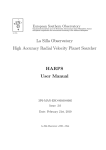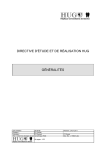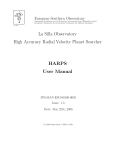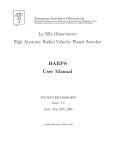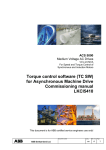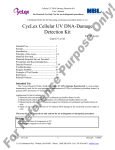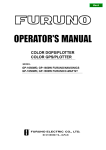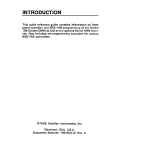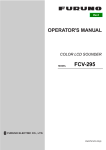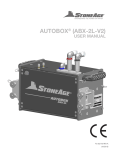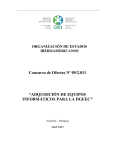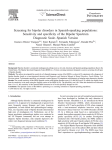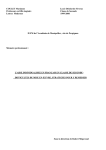Download DRS USER MANUAL Doc. No. 3M6-MAN-HAR-33110-0016
Transcript
HARPS
DRS USER MANUAL
Doc. No. 3M6-MAN-HAR-33110-0016
Issue 1.0
30 september 2003
Prepared: F. Bouchy, D. Queloz
30/09/2003
.............
Signature
Approved: D. Mégevand
............... .............
Date
Released: M. Mayor
Signature
............... .............
Date
Signature
3M6-MAN-HAR-33110-0016, Issue 1.0
i
Change Record
Issue/Rev.
1.0
Date
30/09/2003
Section/Page affected
All
Reason/Remarks
First issue
ii
3M6-MAN-HAR-33110-0016, Issue 1.0
Contents
1 Introduction
1
1.1
Scope . . . . . . . . . . . . . . . . . . . . . . . . . . . . . . . . . . . . . . . . . .
1
1.2
Applicable Documents . . . . . . . . . . . . . . . . . . . . . . . . . . . . . . . . .
1
1.3
Abbreviations and Acronyms . . . . . . . . . . . . . . . . . . . . . . . . . . . . . .
2
2 DRS Hardware and Software Environment
3
2.1
Overview . . . . . . . . . . . . . . . . . . . . . . . . . . . . . . . . . . . . . . . .
3
2.2
Architecture of the data on WHADRS . . . . . . . . . . . . . . . . . . . . . . . . .
3
2.3
Execution of the On-line DRS . . . . . . . . . . . . . . . . . . . . . . . . . . . . .
3
2.4
Execution of the Off-line DRS . . . . . . . . . . . . . . . . . . . . . . . . . . . . .
6
2.5
Programming language . . . . . . . . . . . . . . . . . . . . . . . . . . . . . . . . .
6
2.6
Architecture of the DRS . . . . . . . . . . . . . . . . . . . . . . . . . . . . . . . .
7
2.7
Architecture of the DRS Modules . . . . . . . . . . . . . . . . . . . . . . . . . . .
7
3 On-line DRS Description
9
3.1
Overview . . . . . . . . . . . . . . . . . . . . . . . . . . . . . . . . . . . . . . . .
9
3.2
Recipes . . . . . . . . . . . . . . . . . . . . . . . . . . . . . . . . . . . . . . . . .
9
3.2.1
cal_BIAS - CCD BIAS . . . . . . . . . . . . . . . . . . . . . . . . . . . . .
9
3.2.2
cal_DARK - CCD Dark . . . . . . . . . . . . . . . . . . . . . . . . . . . .
10
3.2.3
cal_loc_ONE - Geometry of orders of One fiber . . . . . . . . . . . . . . . .
10
3.2.4
cal_FF - Flat-field measurement . . . . . . . . . . . . . . . . . . . . . . . .
11
3.2.5
cal_TH - Thorium Calibration . . . . . . . . . . . . . . . . . . . . . . . . .
12
3.2.6
cal_I2 - I spectrum measurement . . . . . . . . . . . . . . . . . . . . . . .
13
3.2.7
obj_TH - Accurate RV measurement . . . . . . . . . . . . . . . . . . . . . .
13
iii
iv
3M6-MAN-HAR-33110-0016, Issue 1.0
3.2.8
obj_ONE - Spectroscopy using One fiber . . . . . . . . . . . . . . . . . . .
14
3.2.9
obj_TWO - Spectroscopy using Two fibers . . . . . . . . . . . . . . . . . .
15
4 DRS Data Product Description
17
4.1
Data naming rules . . . . . . . . . . . . . . . . . . . . . . . . . . . . . . . . . . . .
17
4.2
Data formats . . . . . . . . . . . . . . . . . . . . . . . . . . . . . . . . . . . . . . .
17
4.2.1
Raw frames . . . . . . . . . . . . . . . . . . . . . . . . . . . . . . . . . . .
17
4.2.2
Localization frames _loco_ and _fwhm-order_ . . . . . . . . . . . . . . . .
19
4.2.3
Flat field frames _flat_ . . . . . . . . . . . . . . . . . . . . . . . . . . . . .
19
4.2.4
Blaze frames _blaze_ . . . . . . . . . . . . . . . . . . . . . . . . . . . . . .
20
4.2.5
Wavelength frames _wave_ . . . . . . . . . . . . . . . . . . . . . . . . . .
20
4.2.6
Extracted two-dimensional spectra _e2ds_ . . . . . . . . . . . . . . . . . . .
20
4.2.7
Extracted one-dimensional spectra _s1d_ . . . . . . . . . . . . . . . . . . .
22
4.2.8
Cross-correlation function _ccf_ . . . . . . . . . . . . . . . . . . . . . . . .
22
Summary tables . . . . . . . . . . . . . . . . . . . . . . . . . . . . . . . . . . . . .
23
4.3.1
cal_BIAS_result.tbl . . . . . . . . . . . . . . . . . . . . . . . . . . . . . . .
23
4.3.2
cal_DARK_result.tbl . . . . . . . . . . . . . . . . . . . . . . . . . . . . . .
24
4.3.3
cal_loc_ONE_result.tbl . . . . . . . . . . . . . . . . . . . . . . . . . . . . .
24
4.3.4
cal_FF_result.tbl . . . . . . . . . . . . . . . . . . . . . . . . . . . . . . . .
25
4.3.5
cal_TH_result.tbl . . . . . . . . . . . . . . . . . . . . . . . . . . . . . . . .
25
4.3.6
drift_result.tbl . . . . . . . . . . . . . . . . . . . . . . . . . . . . . . . . .
26
4.3.7
CCF_result.tbl . . . . . . . . . . . . . . . . . . . . . . . . . . . . . . . . .
26
Databases . . . . . . . . . . . . . . . . . . . . . . . . . . . . . . . . . . . . . . . .
27
4.4.1
Calibration Database . . . . . . . . . . . . . . . . . . . . . . . . . . . . . .
27
4.4.2
Reduction Performance list . . . . . . . . . . . . . . . . . . . . . . . . . . .
27
4.4.3
Intrument Configuration Data Pool . . . . . . . . . . . . . . . . . . . . . . .
27
4.4.4
Intrument Performance Database . . . . . . . . . . . . . . . . . . . . . . . .
28
4.3
4.4
5 Off-line DRS Description
29
5.1
Overview . . . . . . . . . . . . . . . . . . . . . . . . . . . . . . . . . . . . . . . .
29
5.2
Recipe . . . . . . . . . . . . . . . . . . . . . . . . . . . . . . . . . . . . . . . . . .
29
3M6-MAN-HAR-33110-0016, Issue 1.0
v
5.2.1
off_visu_e2ds - Display E2DS order . . . . . . . . . . . . . . . . . . . . . .
29
5.2.2
off_visu_s1d - Display S1D spectrum . . . . . . . . . . . . . . . . . . . . .
29
5.2.3
off_visu_ccf - Display CCF . . . . . . . . . . . . . . . . . . . . . . . . . .
30
5.2.4
off_visu_SN - Display S_N per orders . . . . . . . . . . . . . . . . . . . . .
30
5.2.5
off_visu_rvo - Display RV per orders . . . . . . . . . . . . . . . . . . . . .
30
5.2.6
off_newccf - Re-process CCF . . . . . . . . . . . . . . . . . . . . . . . . .
31
6 Use of the Data Archiving Unit
33
vi
3M6-MAN-HAR-33110-0016, Issue 1.0
Chapter 1
Introduction
1.1 Scope
HARPS is a spectrograph dedicated to the search for extra-solar planets by means of the technique
of precise radial velocity measurement. HARPS is developed by a consortium headed by the Geneva
Observatory. It is installed at the Coudé room of the 3.6-m ESO telescope at La Silla, with an optical
fiber link to the Cassegrain focus.
The present document describes the Data Reduction Software (DRS) as well as its current architecture
and configuration. The reader is supposed to be familiar with all the applicable documents listed
below. Chapter 2 describes the Hardware and Software environment of the DRS. Chapter 5 describes
programs, modules and functions of the DRS. Chapter 4 describes the data used and produced by the
DRS.
1.2 Applicable Documents
The following documents, of the exact issue shown, form a part of this document to the extent specified herein.
[1]
[2]
[3]
[4]
[5]
[6]
3M6-SPE-HAR-33100-0002
3M6-PLA-HAR-33100-0005
3M6-TRE-HAR-33110-0005
3M6-TRE-HAR-33110-0006
3M6-TRE-HAR-33110-0019
3M6-TRE-HAR-33110-0008
2.0
1.4
1.1
1.0
1.0
1.31
31/05/2002
11/06/2001
10/07/2001
09/06/2001
12/12/2002
22/01/2002
1
HARPS Tech. Requirements Spec.
HARPS Oper., Calib. and Maint. Plan
HARPS DFS Design Description
HARPS DRS Design Description
HARPS DRS Test and Progress Report
Templates Reference Guide
2
3M6-MAN-HAR-33110-0016, Issue 1.0
1.3 Abbreviations and Acronyms
2D
AFPO
CCD
CCF
CDB
DAU
DFS
DRS
E2DS
ESO
GUI
ICDP
LED
LSO
MS
OG
OS
QC
QE
RMS
RON
RV
RVPO
S1D
SNR
SW
TBD
TBC
VLT
Two Dimension
Average Flux per order
Charge-Coupled Device
Cross Correlation Function
Calibration Database
Data Archiving Unit
Data Flow System
Data Reduction Software
Extracted 2 Dimension Spectra
European Southern Observatory
Graphical User Interface
Instrument Configuration Data Pool
Light-Emitting Diode
ESO Chile (La Silla)
Maintenance Software
Observatoire de Genève
Observing Software
Quality Control
Quantum Efficiency
Root Mean Square
Read-Out Noise
Radial Velocity
Radial Velocity per order
Extracted 1 Dimension Spectra
Signal to Noise Ratio
Software
To Be Defined
To Be Completed
Very Large Telescope
Chapter 2
DRS Hardware and Software Environment
2.1 Overview
The DRS runs on-line on a dedicated HP-UNIX Workstation whadrs. The DRS deals with all the
aspects of the scientific reduction of the raw data, as well as the processing of these reduced data to
extract the radial velocities. The DRS does not interfere with the operation of the instrument, i.e.
observations are independent from the Data Reduction activity. The DFS configuration is illustrated
on Fig. 2.1 and the DRS architecture on Fig. 2.2.
The DRS is designed to run automatically (no user interaction) like a batch process controlled by the
Trigger (see [3]) right after the end of each exposure or at the completion of a sequence of exposures.
It is also possible to use a DRS off-line to display and analyze reduced data.
2.2 Architecture of the data on WHADRS
The raw frames are automatically stored on the directory: /data/raw/YYYY-MM-DD/ where
YYYY-MM-DD is the night directory automatically created at noon. All these directories are automatically created by the DFS system at noon.
The reduced frames are automatically stored in the directory: /data/reduced/YYYY-MM-DD/
The calibration frames are copied in the calibration Data Base directory: /data/calibDB/
The log files of the DRS are stored in the directory: /data/msg/
2.3 Execution of the On-line DRS
On-line DRS is executed by a set of system commands (recipes) send automaticaly by the Trigger.
These recipes need two parameters:
3
4
3M6-MAN-HAR-33110-0016, Issue 1.0
WHARPS
BOB
OS
1 month
Backup
raw frames
WHADHS
OBs
P2PP
reduced data
+ logs
DHS
raw frames
DVD
STS
raw frames
+ reduced data
+ logs
WHADRS
Trigger
Data Arch. Unit
DRS
Figure 2.1: DFS configuration
Data Archiving Unit
RAW FRAMES
Trigger
Calibration DB
LOGS
Reduced Data
DRS
Reduction
Graphical
Display
PERFORMANCE
CONFIG
Figure 2.2: DRS architecture. The DRS is control by the Trigger. Products of the DRS are stored
in "Reduced Data". A calibration data-base ("Calibration DB") is dynamically maintained by the
DRS. Performances and config files are static databases (read-only by the DRS) where all relevant
parameters useful for the DRS are stored. "CONFIG" is used to stored parameters of algorithms and
"PERFORMANCE" to store QC parameters.
3M6-MAN-HAR-33110-0016, Issue 1.0
Exposures type
Templates
HARPS_ech_[...]
Calibration
CCD BIAS
cal_bias
CCD Dark
cal_dark
Geometry of orders
cal_tun
Flat-field sequence
cal_tunAB
Wavelength calibration
cal_thoAB
I spectrum measurement
cal_tunA_I2cell
Science Observations
Accurate RV measurement acq_thosimult
Spectroscopy + I
acq_I2cell
Spectroscopy for object only acq_objA
Spectroscopy object and sky acq_objAB
5
Reduction program
(Recipes)
cal_BIAS
cal_DARK
cal_loc_ONE
cal_FF
cal_TH
cal_I2
obj_TH
obj_ONE
obj_ONE
obj_TWO
Table 2.1: List of on-line data reduction programs.
- night directory name [YYYY-MM-DD]
- raw frame name(s) [HARPS.YYYY-MM-DDTHH:MM:SS.SSS.fits]
(for some recipes a list of raw frame names is needed)
For example, the command:
cal_loc_ONE.py 2002-02-11 HARPS.2002-02-11T20:13:45.768.fits
reduces the raw frame HARPS.2002-02-11T20:13:45.768.fits with the reduction program
cal_loc_ONE. The raw frame is read in the directory /data/raw/2002-02-11/ and all DRS
products are stored in the directory /data/reduced/2002-02-11/. The logs of the DRS are
stored in the file /data/msg/DRS-whadrs.2002-02-11. The list of the raw frames obtained
on a night is stored in the file /data/msg/2002-02-11.r.
The reduction programs are executable files (actually python scripts) that contain all relevant information to carry out the reduction. No other parameters nor options are needed for the reduction.
Parameters specific to the exposure are in the FITS descriptors of the raw frame.
The Trigger runs automatically the appropriate reduction program of each frame or set of frames
as soon as the exposure is archived and available on the DRS machine. The reduction programs
associated to each template types are listed in the table 2.1.
The on-line trigger is executed on the WHADRS workstation (under user harps) with the command:
trig.csh online
6
3M6-MAN-HAR-33110-0016, Issue 1.0
Description
Reduction program
Visualization
Display one order of the E2DS spectrum off_visu_e2ds
Display a domain of the S1D spectrum off_visu_s1d
Display SNR per orders
off_visu_SN
Display the CCF and its parameters
off_visu_ccf
Display the RV per orders
off_visu_rvo
Radial velocity re-computation
Compute the CCF
off_newccf
Table 2.2: List of off-line data reduction programs.
2.4 Execution of the Off-line DRS
The Off-line DRS is used to display and analyze reduced data. Off-line DRS is executed by a set of
system commands (recipes) send manually through a dedicated GUI or directly from the prompter.
The reduction programs associated to reduced datas are listed in the table 2.2.
2.5 Programming language
The programming language is Python, a powerful, object-oriented, interpreter programming language that is easy to extend, freely distributed, and available for most computer platforms (see
http://www.python.org/ and http://www.vex.net/parnassus/).
The following python modules are needed by the DRS:
Mathematical and Numerical (Numeric)
Graphical and visualization (Gnuplot)
FITS format manipulation (pcfitsio, fitsio)
User interface (Tkinter)
system and files (sys,time,shutil,os)
string manipulation (string)
Fortran program interface (f2py)
Most of these modules are part of the python 2.1.1 distribution version. DRS is currently running on
this version.
Some specific algorithm of the DRS are written in Fortran in order to increase the DRS execution.
3M6-MAN-HAR-33110-0016, Issue 1.0
7
They are included in Python library through the Fortran program interface f2py.
2.6 Architecture of the DRS
All the directories and files related to the Data Reduction Software of HARPS are stored on the
directory: /home/harmgr/INTROOT/DRS/
From this point:
Contains all the Instrument Configuration Data files used by the DRS.
Contains all useful documents, notes and manuals related to the DRS.
Contains all the executable programs or their links.
Contains all the fortran sources name.f and their associated python
modules namemodule.sl.
./python
Contains the python executable python.csh and two initialization file
startup.py and startup_recipes.py.
./python/f2pymodule Contains all the modules based on fortran code and their test python
scripts.
./python/Recipes
Contains all the python reduction programs.
./python/Modules
Contains all the python modules used by the reduction programs.
./config
./docs
./scripts
./fortran
2.7 Architecture of the DRS Modules
All the functions used by the reduction programs are grouped in modules related to a specific application. Table 2.3 describes all the modules used by the Data Reduction programs and their field of
application.
8
3M6-MAN-HAR-33110-0016, Issue 1.0
module name
description
hadmrBIAS
hadmrCDB
hadmrDARK
hadmrEXTOR
hadmrFITS
hadmrFLAT
hadmrLOCOR
hadmrRV
hadmrTHORCA
hadrgdCONFIG
hadgtVISU
hadgtMATH
Bias Measurement and Correction
Calibration Database access functions
Dark Measurement and correction functions
Extraction of Orders
Manipulate FITS
Flat field Measurement and correction functions
Localization of orders
Calculation of velocity (Earth, drift, stellar)
Thorium Calibration
Configuration Panel Function of the RGD
Graphical functions
Mathematical functions
Table 2.3: List of the modules used by the Reduction programs.
Chapter 3
On-line DRS Description
3.1 Overview
The On-line Data Reduction is automatically executed with the Trigger which can be started by typing
the command: trig.csh online on the whadrs (under user haprs).
3.2 Recipes
Recipes are made of specific functions available in the Modules specifically developed for the HARPS
DRS (see Table 2.3) or part of the distribution of python modules (see in section 2.5). Dependencies
between recipes and modules can be found in the DRS design document. We present in this chapter a
description of the reduction task carried out by each recipes.
3.2.1 cal_BIAS - CCD BIAS
Inputs
Raw fits frame obtained with the HARPS_ech_cal_bias template
Description
- Read keywords related to the CCDs parameters (readout mode,readout noise, gain)
- Correction of the bad columns of the CCDs (average of adjacent columns)
- Measurement of the mean level and the dispersion of the 4 overscan areas
- Measurement of the mean level and the dispersion of the 4 CCD ports
- Print and Display of the results
- Store results on the file cal_BIAS_result.tbl
Outputs
- Ascii file cal_BIAS_result.tbl
9
10
3M6-MAN-HAR-33110-0016, Issue 1.0
Quality control
- Quality control with warning message when bias level > 500 ADU or bias noise > 10 e-
3.2.2 cal_DARK - CCD Dark
Inputs
Raw fits frame obtained with the HARPS_ech_cal_dark template
Description
- Read keywords related to the CCDs parameters (readout mode,readout noise, gain)
- Correction of the bad columns of the CCDs (average of adjacent columns)
- Mean level and dispersion of the Bias on the 4 overscan areas
- Mean level and dispersion of the 4 CCD ports with sigma clipping of the cosmic hits
- Calculation of the mean dark level (e-/hour)
- Calculation of the number of cosmic events (event/cm2/mn)
- Store result on the file cal_DARK_result.tbl
Outputs
Ascii file cal_DARK_result.tbl
Quality control
- Error message if the exposure time is shorter than 5 minutes, DRS stoppped.
- Warning if dark level > 10 e-/hour or cosmic events > 10 event/cm2/mn
3.2.3 cal_loc_ONE - Geometry of orders of One fiber
Inputs
Two raw fits frames obtained from a sequence of two successive Tungsten exposures with the
HARPS_ech_cal_tun template for each fibers A and B.
Description
- Retrieve from calibDB previous last full calibration sets - Read keywords related to the CCDs parameters (readout mode,readout noise, gain)
- Read keywords related to the exposure type in order to determine the illuminated fiber
- Correction of the bad columns of the CCDs (average of adjacent columns)
- Correction of the BIAS determined in the 4 overscan areas. The bias is determined for each of
the 4096 rows by average of the 50 columns. This skeem allow to conserve and correct the possible
structure of the bias when the CCDs are illuminated.
- Resize of the raw frame and cut through all the spectral orders on the central row of the CCD
- Renormalization the central row in order to put all orders at the same level
- Find all orders in the normalized central row greater than 0.15. This first step allow to find the 72
orders of fiber A and the 71 orders of fiber B listed in Table 6.1. - From these starting points order
position are searched and located by 20 pixel steps. At each point, profile of each order is fitted by a
3M6-MAN-HAR-33110-0016, Issue 1.0
11
gaussian in order to measure its center and fwhm. On the whole frame centers and FHWM of each
order are determined on 200 points.
- A 4th degrees polynome is fitted for each order to constrain the center and to measure its FWHM.
The typical RMS of the fit is 25 mpixels for the centering (75 mpixels for the fwhm). The FWHM
ranges of orders from 3 to 4 pixels.
- The position x of the center of each orders for each rows y is stored in a FITS file with the suffix
loco
- The FWHM of each orders for each rows y is stored in a FITS file with the suffix fwhm-order
- Parameters of 3 orders are appended in the file cal_loc_ONE_result.tbl
- Quality control on the number of orders identified, dispersion of the center and FWHM.
- If passed the Quality control updates the Calibration Data Base.
Outputs
Ascii file cal_loc_ONE_result.tbl
Fits files [generic name]_loco_A.fits and [generic name]_loco_B.fits
Fits files [generic name]_fwhm-order_A.fits and [generic name]_fwhm-order_B.fits
Quality control
- Error if flux level on the central row (65000 ADU > Flux > 15000 ADU), DRS stops
- Quality control on the number of orders (72/71) dispersion of the fit both on center and FWHM
values of order profiles (
[pix]). If Quality control fails calibDB is not updated
3.2.4 cal_FF - Flat-field measurement
Inputs
Several raw fits frames obtained from a sequence of Tungsten exposures on the two fibers with the
HARPS_ech_cal_tunAB template or HARPS_ech_cal_tunUSER (at least 5 frames in order to reach
the photon noise level above the flat-field noise).
Description
- Retrieve from calibDB previous last full calibration sets - Sum of the raw frame delivered
- Correction of the bad columns of the CCDs (average of adjacent columns)
- Correction of the BIAS as described previously
- Read the last localisation in the Calibration Data Base
- Horn optimum extraction of orders
- A box window is used to smooth the tungsten flux along the orders to determine a "pseudo"-blaze
response.
- Divide the extracted tungsten spectrum by this blaze response to obtain the flat field spectrum.
- Computation of the SNR at the blaze center and the dispersion of the flat field
- The Blaze for each orders is stored in a FITS file with the suffix blaze
- The Flat for each orders is stored in a FITS file with the suffix flat
- Parameters of 3 orders are appended in the file cal_FF_result.tbl
- If passed Quality control update the Calibration Data Base.
12
3M6-MAN-HAR-33110-0016, Issue 1.0
Outputs
Ascii file cal_FF_result.tbl
Fits files [generic name]_blaze_A.fits and [generic name]_blaze_B.fits
Fits files [generic name]_flat_A.fits and [generic name]_flat_B.fits
Quality control
- check staturation level, stop DRS if saturated
- check FF parameters (rms
[e-]; S/N ), CalibDB is not updated if failed
3.2.5 cal_TH - Thorium Calibration
Inputs
Raw fits frame obtained with the HARPS_ech_cal_thoAB template
Description
- Retrieve from calibDB previous last full calibration sets - Correction of the bad columns of the
CCDs (average of adjacent columns)
- Correction of the BIAS as described previously
- Fit on raw frame a small set of thorium lines and save parameters in a tbl file with suffix spot_thAB
- Read the last localisation and flat field in the Calibration Data Base
- Horn optimum extraction of orders
- Flat field correction
- Compute the RV drift from the last Th Calibration in the Calibration Data Base.
- Identify lines using calibration provided by calibDB (if calibration is not available: "first wavelength
calibration" procedure must be used)
- Fit each thorium emission line - Adjust a polynomial solution for each order with a sigma-clipping
scheme
- Compute the Littrow first and second order deviation and computes the granulation of the global
solution - Save E2DS Thorium spectrum in FITS file with the suffix e2ds with all descriptors.
- Save an image of the wavelength solution (wavelength of each orders for each pixels) in FITS file
with the suffix wave.
- Parameters of the Thorium wavelength calibration are appended in the file cal_TH_result.tbl.
- Listing of all Thorium lines detected are stored in a tbl file with suffix th_lines.
- If passed Quality control update the Calibration Data Base.
Outputs
Ascii file cal_TH_result.tbl
Ascii file [generic name]_spot_thAB.tbl
Ascii file [generic name]_th_lines_A.tbl
Ascii file [generic name]_th_lines_B.tbl
Fits files [generic name]_e2ds_A.fits and [generic name]_e2ds_B.fits
Fits files [generic name]_wave_A.fits and [generic name]_wave_B.fits
Quality control
3M6-MAN-HAR-33110-0016, Issue 1.0
13
- Check if Littrow solution has rms granulation less than 50m/s. if found greater calibDB is not
updated
3.2.6 cal_I2 - I spectrum measurement
Inputs
Raw fits frame obtained with the HARPS_ech_cal_tunAI2 template
Description
- Retreive from calibDB previous last full calibration sets - Correction of the bad columns of the
CCDs (average of adjacent columns)
- Correction of the BIAS as described previously
- Read the last localisation, flat field and wavelength solution in the Calibration Data Base
- Horn optimum extraction of orders
- Flat field correction
- Save E2DS Thorium spectrum in FITS file with the suffix e2ds with all descriptors.
Outputs
Fits files [generic name]_e2ds_A.fits
Quality control
- Error if saturation level reached on I spectrum, DRS stops
3.2.7 obj_TH - Accurate RV measurement
Inputs Raw fits frame obtained with the HARPS_ech_acq_thosimult template
Description - Retreive from calibDB previous last full calibration sets - Correction of the bad columns
of the CCDs (average of adjacent columns)
- Correction of the BIAS as described previously
- Read the last localisation, flat field, wavelength solution and Thorium reference spectrum in the
Calibration Data Base
- Horn optimum extraction of orders
- Flat field correction
- Save E2DS Thorium spectrum in FITS file with the suffix e2ds with all descriptors.
- Compute the rebinned and merged spectrum S1D and save it with the suffix s1d.
- Compute the instrumental drift with the Thorium spectrum relative to the last Thorium reference in
the Calibration Data Base and save the result in the file drift_result.tbl.
- Compute the Barycentric Earth Radial Velocity.
- Compute the cross correlation function with a template mask driven by the spectral type and save the
average CCF on the fits file [generic name]_ccf_mask_A.fits, the RV for each orders in the table
[generic name]_ccf_mask_A.tbl, and the summary of results on the table CCF_result.tbl.
Outputs
Ascii file drift_result.tbl
14
3M6-MAN-HAR-33110-0016, Issue 1.0
Ascii file CCF_result.tbl
Fits files [generic name]_e2ds_A.fits
Fits files [generic name]_e2ds_B.fits
Fits files [generic name]_s1d_A.fits
Fits files [generic name]_s1d_B.fits
Fits files [generic name]_ccf_mask_A.fits
Fits files [generic name]_ccf_mask_A.tbl
Quality control
- Warning if saturation level reached
3.2.8 obj_ONE - Spectroscopy using One fiber
Inputs Raw fits frame obtained with the HARPS_ech_acq_objA template
Description - Retrieve from calibDB previous last full calibration sets - Correction of the bad columns
of the CCDs (average of adjacent columns)
- Correction of the BIAS as described previously
- Read the last localisation, flat field, wavelength solution and Thorium reference spectrum in the
Calibration Data Base
- Horn optimum extraction of orders
- Flat field correction
- Save E2DS Thorium spectrum in FITS file with the suffix e2ds with all descriptors.
- Compute the rebinned and merged spectrum S1D and save it with the suffix s1d.
- Compute the Barycentric Earth Radial Velocity.
- Compute the cross correlation function with a template mask driven by the spectral type and save the
average CCF in the fits file [generic name]_ccf_mask_A.fits, the RV for each orders in the table
[generic name]_ccf_mask_A.tbl, and the summary of results on the table CCF_result.tbl.
Outputs
Ascii file CCF_result.tbl
Fits files [generic name]_e2ds_A.fits
Fits files [generic name]_e2ds_B.fits
Fits files [generic name]_s1d_A.fits
Fits files [generic name]_s1d_B.fits
Fits files [generic name]_ccf_mask_A.fits
Fits files [generic name]_ccf_mask_A.tbl
Quality control
- Warning if saturation level reached
3M6-MAN-HAR-33110-0016, Issue 1.0
15
3.2.9 obj_TWO - Spectroscopy using Two fibers
Inputs Raw fits frame obtained with the HARPS_ech_acq_objAB template
Description - Retrieve from calibDB previous last full calibration sets - Correction of the bad columns
of the CCDs (average of adjacent columns)
- Correction of the BIAS as described previously
- Read the last localisation, flat field, wavelength solution and Thorium reference spectrum in the
Calibration Data Base
- Horn optimum extraction of orders
- Flat field correction
- Save E2DS Thorium spectrum in FITS file with the suffix e2ds with all descriptors.
- Compute the rebinned and merged spectrum S1D and save it with the suffix s1d.
- Compute the Barycentric Earth Radial Velocity.
- Compute the cross correlation function with a template mask driven by the spectral type for both
fibers and save the average CCF on the fits file [generic name]_ccf_mask_A.fits, the RV for
each orders in the table [generic name]_ccf_mask_A.tbl, and the summary of results on the table CCF_result.tbl.
Outputs
Ascii file CCF_result.tbl
Fits files [generic name]_e2ds_A.fits
Fits files [generic name]_e2ds_B.fits
Fits files [generic name]_s1d_A.fits
Fits files [generic name]_s1d_B.fits
Fits files [generic name]_ccf_mask_A.fits
Fits files [generic name]_ccf_mask_A.tbl
Fits files [generic name]_ccf_mask_B.fits
Fits files [generic name]_ccf_mask_B.tbl
Quality control
- Warning if saturation level reached
16
3M6-MAN-HAR-33110-0016, Issue 1.0
Chapter 4
DRS Data Product Description
4.1 Data naming rules
The raw frames are stored on FITS format by the DFS with the ESO-VLT standard naming rules:
HARPS.YYYY-MM-DDTHH:MM:SS.SSS.fits with YYYY-MM-DD and HH:MM:SS.SSS being
respectively the date and time of the begining of observation.
Image products of the DRS are stored on FITS format with the same generic names plus a additional
suffix describing its format (see next section for details) and the specific fiber name (A or B). For
example : HARPS.YYYY-MM-DDTHH:MM:SS.SSS_e2ds_A.fits is an E2DS format image
of the fiber A product by the DRS from the HARPS.YYYY-MM-DDTHH:MM:SS.SSS.fits raw
frame
Tables in ASCII format are also produced by the DRS. See in Table TBC for a list and a description
of the content of tables.
The relevant log-books of the DRS is named DRS-whadrs.YYYY-MM-DD.
4.2 Data formats
4.2.1 Raw frames
The raw frame corresponds to a 4296 x 4096 integer (35’242’560 bytes) matrix written on disk in
FITS format (see Fig. 4.1). This images includes a 4096x4096 sensitive zone plus 4 over and prescan
zone of 50 pixels each. The following generic descriptors are used by the DRS:
DATE-OBS
Date and Time of beginning of observation [string]
RA
RA of the target [float]
DEC
DEC of the target [float]
17
18
3M6-MAN-HAR-33110-0016, Issue 1.0
The DRS needs as well the following HIERARCH ESO descriptors:
DET READ SPEED CCD Readout mode (speed, port and gain) [string]
DET OUT2 RON
Readout noise (e-) of Linda (Blue) [float]
DET OUT2 CONAD Conversion from ADUs to electrons of Linda (Blue) [float]
DET OUT4 RON
Readout noise (e-) of Jasmin (Red) [float]
DET OUT4 CONAD Conversion from ADUs to electrons of Jasmin (Red) [float]
DET WIN1 DIT1
Actual sub-integration time (s) [float]
DET WIN1 DKTM
Dark current time (s) [float]
DET DPR CATG
Observation category [string]
DET DPR TYPE
Exposure type [string]
INS DET1 TMMEAN Normalised mean exposure time [float]
INS DET1 CMMEAN Average count PM on fiber A [float]
INS DET2 CMMEAN Average count PM on fiber B [float]
OBS TARG NAME
Target name [string]
TEL TARG EQUINOX Equinox [float]
TEL TARG PMA
Proper motion alpha (arcsec/year) [float]
TEL TARG PMD
Proper motion delta (arcsec/year) [float]
TEL TARG RADVEL Radial velocity of target (km/s) [float]
TEL AMBI FWHM START seeing at start [float]
TEL AMBI FWHM END seeing at end [float]
TEL AIRM START
air mass at start [float]
TEL AIRM END
air mass at end [float]
TPL NEXP
TPL Number of exposures [integer]
TPL EXPNO
TPL Exposure number within template [integer]
TPL NAME
TPL NAME [string]
3M6-MAN-HAR-33110-0016, Issue 1.0
19
[x=4296,y=4096]
overscan
50
pixels
[x=4296,y=1]
RED
λ
4296 columns
JASMIN
CCD
prescan
50
pixels
overscan
50
pixels
λ
BLUE
LINDA CCD
prescan
50
pixels
[x=1,y=4096]
4096 raws
[x=1,y=1]
Figure 4.1: Raw frame format. The raw image is oriented in order to correspond to the CCD orientation in focal plane when looking at the detector from the spectrograph.
4.2.2 Localization frames _loco_ and _fwhm-order_
Centers and FWHM of orders are stored in two 4096 x (n ) real matrix written on disk in FITS
format with the suffix _loco_ and _fwhm-order_ added to the generic name. Each lines corresponds
to an order and each column to a line of the CCD raw frame. The localization frame _loco_ contains
the position of the center positions of orders. The localization frame _fwhm-order_ contains the
FWHM of orders. Pay attention to the orientation of the raw frame by comparison with the E2DS
format described below. The FITS descriptor includes all descriptors of the raw frame. In addition,
the order position are stored with the following HIERARCH ESO DRS fits descriptor:
CAL LOC NBO
number of orders localized [int]
CAL LOC DEG
degree of the polynomial fit [int]
CAL LOC CTRi
Coeffi for center order (i = NBO x DEG) [float]
CAL LOC FWHMi
Coeffi for fwhm order (i = NBO x DEG) [float]
4.2.3 Flat field frames _flat_
The Flat field frame is a 4096 x (norder) real matrix written on disk in FITS format with the _flat_
suffix added to the generic name. Each lines contains the normalized flat field spectrum of the orders.
The row numbering of the matrix corresponds to the inverse of the column of the raw frame in order to
have wavelength increasing with pixels (see on Fig. 4.1). The FITS descriptor includes all descriptors
20
3M6-MAN-HAR-33110-0016, Issue 1.0
of the raw frame.
4.2.4 Blaze frames _blaze_
The Blaze frame is a 4096 x (norder) real matrix written on disk in FITS format with the _blaze_
suffix added to the generic name. Each lines contains the pseudo blaze reponse of the orders. The row
numbering of the matrix corresponds to the inverse of the column of the raw frame in order to have
wavelength increasing with pixels (see on Fig. 4.1). The FITS descriptor includes all descriptors of
the raw frame.
4.2.5 Wavelength frames _wave_
The wavelength frame is a 4096 x (norder) real matrix written on disk in FITS format with the
_wave_ suffix added to the generic name. Each lines contains the wavelength calibration of the
orders. The row numbering of the matrix corresponds to the inverse of the column of the raw frame
in order to have wavelength increasing with pixels (see on Fig. 4.1). The FITS descriptor includes all
descriptors of the raw frame.
4.2.6 Extracted two-dimensional spectra _e2ds_
The extracted two-dimensional spectra (E2DS) is a 4096 x (n ) real matrix written on disk in FITS
format with the _e2ds_ suffix added to the generic name. Each line contains the extracted flux
of one spectral order in photo-electrons unit. The line numbering of the matrix corresponds to the
inverse of the column numbering of the raw frame in order to have wavelength increasing with pixels
on E2DS format. The FITS descriptor includes all descriptors of the raw frame. The following extra
descriptor HIERARCH ESO DRS related to the localization, flat-field, Barycentric Earth Radial
Velocity, Instrumental drift and wavelength calibration are included :
CAL LOC FILE
Localization file used [string]
CAL EXT OPT
Option extraction [integer]
CAL EXT SIG
Size extraction zone [float]
CAL EXT COSM
threshold cosmic detection [float]
CAL EXT SNi
S_N order center i [float]
CAL EXT NBCOSi
NbCos detected order i [integer]
CAL FLAT WIN
half size blaze window [integer]
CAL FLAT FILE
Flat file used [string]
3M6-MAN-HAR-33110-0016, Issue 1.0
CAL FLAT NBFILES Nb of Flat files used [integer]
CAL FLAT RMSi
FF RMS order i [float]
CAL ADDED NBRFILES Nb of raw files processed [integer]
CAL ADDED FILES Files name of raw files used [string]
BERV
Barycentric Earth Radial Velocity [float]
BJD
Barycentric Julian Day [float]
BERVMX
Maximum BERV [float]
CAL TH FILE
Wavelength file used [string]
DRIFT REF FILE
Th Drift ref file used [string]
DRIFT VR
Th RV Drift (m/s) [float]
DRIFT NBCOS
Th Drift Nbr cosmic detected [integer]
DRIFT RFLUX
Th Drift Flux ratio [float]
DRIFT NBORDKILL Th Drift Nb orders killed [integer]
DRIFT NOISE
Th Drift photon noise (m/s) [float]
CAL TH ORDER NBR nbr of orders in total [int]
CAL TH ORDER START numbering of the first blue order [int]
CAL TH ORDER NBLUE nbr of blue orders [int]
CAL TH ORDER NGAP nbr of orders in the gap [int]
CAL TH ORDER NRED nbr of red orders [int]
CAL TH GUESS ORDER nbr of the first guess order [int]
CAL TH GUESS LINES file name for first guess lines [string]
CAL TH LINES
file name for tbl of cal lines [string]
CAL TH DEG LL
degre polyn fit ll(x,order) [int]
CAL TH DEG X
degre polyn fit x(ll,order) [int]
CAL TH COEFF LL coeff for ll(x,order) [dbl precision]
CAL TH COEFF X
coeff for x=(ll,order) [dbl precision]
21
22
3M6-MAN-HAR-33110-0016, Issue 1.0
The wavelength calibration
is related to the coefficient with the following equation:
!"#$ %& (4.1)
where d = ESO DRS CAL TH DEG LL, bf = ESO DRS CAL TH COEFF LL and the internal numbering of the order (raw number in the e2ds frame).
For thorium spectrum an extension _wave_ is also produced by the DRS. It is a e2ds format image
where the matrix stores the wavelength value of each pixel instead of the flux of the spectrum.
4.2.7 Extracted one-dimensional spectra _s1d_
The extracted one-dimensional spectra (S1D) is a real vector written on disk in FITS format with the
_s1d_ suffix added to the generic name. This vector contains the rebinned and merged spectral orders
in relative flux corrected from the instrumental respond and stretched to the barycentric referential.
The wavelength step is 0.01 Angstrom.
4.2.8 Cross-correlation function _ccf_
The cross correlation function is stored with the suffix _ccf_[template_name] with template_name
the file name of the corresponding template (also called coorelation mask) used to compute it. The
matrix is made of n CCF spectrum corresponding to the CCF computed for each order. The
following extra descriptor HIERARCH ESO DRS related to CCF are included:
CCF MASK
template filename
CCF MAXCPP
max count/pixel in the continuum of the CCF (e-)
CCF FWHM
FWHM of CCF (km/s) [gaussian fit]
CCF RV
Baryc Rad vel (km/s) [gaussian fit]
CCF LINES
nbr of lines used by the template
CCF CONTRAST
Contrast of CCF (%) [gaussian fit]
BERV
Barycentric Earth Radial Velocity correction
BJD
Barycentric Julian Day
BERVMX
Maximum BERV along the year
DRIFT REF FILE
Th Drift ref file used [string]
DRIFT VR
Th RV Drift (m/s) [float]
3M6-MAN-HAR-33110-0016, Issue 1.0
DRIFT NBCOS
Th Drift Nbr cosmic detected [integer]
DRIFT RFLUX
Th Drift Flux ratio [float]
23
DRIFT NBORDKILL Th Drift Nb orders killed [integer]
DRIFT NOISE
Th Drift photon noise (m/s) [float]
4.3 Summary tables
The DRS produces a set of summary table for performance tracking of calibration exposure.The tables
have ASCII format with a TAB for separator:
cal_BIAS_result.tbl
cal_DARK_result.tbl
cal_loc_ONE_result.tbl
cal_FF_result.tbl
cal_TH_result.tbl
drift_result.tbl
CCF_result.tbl
for BIAS
for DARK
for the order localization
for Flat-Field
for thorium calibration
for instrumental drift
for CCF
4.3.1 cal_BIAS_result.tbl
column description:
night_name
name of the night directory
file_name
name of the corresponding raw frame
ccd_mode
CCD read out mode
mean_bias1
mean bias in zone 1 (prescan Linda) (ADU)
rms_bias1
rms bias in zone 1 (prescan Linda) (ADU)
mean_bias2
mean bias in zone 2 (overscan Linda) (ADU)
rms_bias2
rms bias in zone 2 (overscan Linda) (ADU)
mean_bias3
mean bias in zone 3 (prescan Jasmin) (ADU)
rms_bias3
rms bias in zone 3 (prescan Jasmin) (ADU)
mean_bias4
mean bias in zone 4 (overscan Jasmin) (ADU)
rms_bias4
rms bias in zone 4 (overscan Jasmin) (ADU)
24
3M6-MAN-HAR-33110-0016, Issue 1.0
4.3.2 cal_DARK_result.tbl
column description:
night_name
name of the night directory
file_name
name of the corresponding raw frame
ccd_mode
CCD read out mode
dark_time
dark exposure time (s)
mean_dark
mean dark level (e-/hour)
cosmic
number of cosmic events (event/cm2/mn)
4.3.3 cal_loc_ONE_result.tbl
column description:
night_name
name of the night directory
file_name
name of the corresponding raw frame
fiber
fiber name (A or B)
posx_161
location of the center of the order 161 [pixel]
err_posx_161
error on order location [pixel]
fwhm_161
width of the center of the order 161 [pixel]
err_fwhm_161
error on the width of the center of the order 161 [pixel]
posx_114
same than above for order 114
err_posx_114
same than above for order 114
fwhm_114
same than above for order 114
err_fwhm_114
same than above for order 114
posx_89
same than above for order 89
err_posx_89
same than above for order 89
fwhm_89
same than above for order 89
err_fwhm_89
same than above for order 89
3M6-MAN-HAR-33110-0016, Issue 1.0
4.3.4 cal_FF_result.tbl
column description:
night_name
name of the night directory
file_name
name of the corresponding raw frame
nbfiles
number of frame coadded
fiber
fiber name (A or B)
FFrms_161
rms on the flat-field at center of order 116
S_N_161
S/N ratio per extracted pixel at center of order 161
FFrms_114
same than above for order 114
S_N_114
same than above for order 114
FFrms_89
same than above for order 89
S_N_89
same than above for order 89
4.3.5 cal_TH_result.tbl
column description:
night_name
name of the night directory
file_name
name of the corresponding raw frame
fiber
fiber name (A or B)
mean
mean value of the final solution in mpixel
rms
rms on the final solution in mpixel
N_lines
number of lines used in the final solution
err
internal error in the final solution in mpixel
rms_L0
rms on Littrow at cut #1 in mpixel
rms_L1
rms on Littrow at cut #2 in mpixel
rms_L2
rms on Littrow at cut #3 in mpixel
drift
drift in m/s compared to previous wavelength solution
25
26
3M6-MAN-HAR-33110-0016, Issue 1.0
Rflux
flux ration by comparison with the previous solution
Ccosmic
number of corrected cosmic
ll1ref
wavelenth of reference line #1
ampl1ref
amplitude in (e-) of the reference line #1
ll2ref
wavelenth of reference line #2
ampl2ref
amplitude in (e-) of the reference line #2
error_spe
estimate of the velocity photon noise error of the spectrum
4.3.6 drift_result.tbl
column description:
night
name of the night directory
e2ds_file_name
name of the corresponding thorium e2ds spectrum
reference
name of the thorium e2ds spectrum used as reference
exp_time
exposure time (s)
VR_drift
Instrumental Drift (m/s) (To Add to the CCF result)
Nbcosmic
Nb cosmic corrected
Flu_ratio
Flux ratio between thorium spectrum and reference
Nborders_killed
Nb order killed by the process
4.3.7 CCF_result.tbl
column description:
night_name
name of the night directory
file_name
name of the corresponding thorium e2ds spectrum
fiber
fiber ’A’ or ’B’
mask
Name of the ccf template
maxccp
Maximum of count per pixel in the CCF
3M6-MAN-HAR-33110-0016, Issue 1.0
lines
Number of spectral lines used in the CCF
contrast
Contrast of the CCF (%)
RV
RV (km/s) corrected from BERV
FWHM
FWHM of the CCF (km/s)
27
4.4 Databases
Several Databases are accessed by the DRS. The DRS uses Calibrations Databases to store and to
retrieve calibrations. Its needs a Reduction Performance List for the quality control. The DRS main
engine uses the Instrument Configuration Data Pool as input reference to carry on the reduction.
4.4.1 Calibration Database
The Calibration Databases includes all relevant calibrations which have passed properly the quality
control tests. It contains BIAS frames, DARK frames, localization images, flat-fields, and thorium
calibrated spectra. A master_calib.tbl file keeps track of all the calibration frames. All calibration
frames needed and accessed by the DRS during the reduction process are automatically copied on
the directory where all data product of the DRS are stored. This allow the observer to have a selfconsistent set of data products if he wants to reprocess his observations
Calibration Database stores a full calibration set made of:
order localisation (A and B)
flat-field and blaze spectrum (A and B)
wavelenth solution (A and B)
reference thorium spectrum (B)
4.4.2 Reduction Performance list
The reduction performance list contains all the DRS parameters that are checked by the Quality
Control process. This list is stored on the /config/ directory.
4.4.3 Intrument Configuration Data Pool
All the fixed parameters needed by the DRS are in the file hadmrICDP.py on the directory /config/. In this file, one finds the characteristics of the CCD, mapping of the FITS descriptor to DRS
28
3M6-MAN-HAR-33110-0016, Issue 1.0
variable, and all the parameters of DRS algorithms optimized for HARPS.
4.4.4 Intrument Performance Database
All DRS outcome helpful to track instrument performance are stored on the table files
cal_BIAS_result.tbl, cal_DARK_result.tbl, cal_loc_one_result.tbl,
cal_FF_result.tbl, and cal_TH_result.tbl, [generic name]_spot_thAB.tbl,
[generic name]_th_lines_A.tbl, [generic name]_th_lines_B.tbl.
Chapter 5
Off-line DRS Description
5.1 Overview
The Data Reduction Off-line corresponds to a set of tools offer to the user through a Graphical User
Interface to display and analyze the reduced data provided by the On-line DRS. The outputs of the
Off-line DRS are generated in the local directory. Unfortunately the GUI of the Off-line DRS has not
been tested during the third commissioning and will not be available before January 2004. However
users can send manually the off-line recipes like commands following by parameters as described in
the next section. Note that these tools are not essential to analyze reduced data since their format is
completely compatible with Midas or other tools.
5.2 Recipe
5.2.1 off_visu_e2ds - Display E2DS order
off_visu_e2ds.py [night] [e2dsfits] [order_number] [ps]
[night]
Night directory (2002-02-11)
[e2dsfits]
E2DS fits file (HARPS.2002-02-11T20:13:45.768_e2ds_A.fits)
[order_number]
Order number (0-71) default value = 49
[ps]
Poscript file output option (0/1) default value = 0
5.2.2 off_visu_s1d - Display S1D spectrum
off_visu_s1d.py [night] [s1dfits] [lambda_start] [lambda_end] [ps]
29
30
3M6-MAN-HAR-33110-0016, Issue 1.0
[night]
Night directory (2002-02-11)
[s1dfits]
S1d fits file (HARPS.2002-02-11T20:13:45.768_s1d_A.fits)
[lambda_start]
First wavelentgh (Angstrom) default value 3780
[lambda_end]
Last wavelentgh (Angstrom) default value 6912
[ps]
Poscript file output option (0/1) it default value = 0
5.2.3 off_visu_ccf - Display CCF
off_visu_ccf.py [night] [ccffits] [ps]
[night]
The night directory (2002-02-11)
[ccffits]
CCf fits file (HARPS.2002-02-11T20:13:45.768_ccf_G2_A.fits)
[ps]
Poscript file output option (0/1) it default value = 0
5.2.4 off_visu_SN - Display S_N per orders
off_visu_SN.py [night] [e2dsfits] [ps]
[night]
The night directory (2002-02-11)
[e2dsfits]
CCf fits file (HARPS.2002-02-11T20:13:45.768_e2ds_A.fits)
[ps]
Poscript file output option (0/1) it default value = 0
5.2.5 off_visu_rvo - Display RV per orders
off_visu_rvo.py [night] [ccftbl] [ps]
[night]
The night directory (2002-02-11)
[ccftbl]
Table CCF file (HARPS.2002-02-11T20:13:45.768_ccf_G2_A.tbl)
[ps]
Poscript file output option (0/1) it default value = 0
3M6-MAN-HAR-33110-0016, Issue 1.0
31
5.2.6 off_newccf - Re-process CCF
off_newccf.py [night] [e2dsfits] [maskfilename] [targetRV] [widthccf]
[stepccf]
[night]
The night directory (2002-02-11)
[e2ds]
E2DS fits file (HARPS.2002-02-11T20:13:45.768_e2ds_A.tbl)
[maskfilename]
Template of correlation (K0.mas) default is G2.mas
[targetRV]
Target Radial Velocity (km/s) defaut is 0.
[widthccf]
Windows of the CFF (km/s) default is 20 km/s
[stepccf]
Step of the CCF (km/s) default is 1 km/s
The new CCF is saved in the file [generic name]_newwccf_mask_A.fits
32
3M6-MAN-HAR-33110-0016, Issue 1.0
Chapter 6
Use of the Data Archiving Unit
This appendix describes the use of the Data Archiving Unit (DAU). This unit allows the VA to write
his/her data (raw and reduced) to DVD.
In order to archive the data of one night the following has to be done:
1. Launch the Data Archiving Unit on the wharch machine as harps user with the command
dau.csh (do not send it in a background process).
2. Indicate the night date in the “Night” field (the only one which is white); pressing “Enter” key
validates the entered value. The process scan the corresponding night directory in the whadrs
workstation and compute the size in MB.
3. Select the Backup buttons of the data files you want to archive and click on the "Go" button
to start the backup. Files are then copied in the wharch workstation under the /BACKUP/
directory.
4. De-select the backup button and check that the Size is less than 4400 MB.
5. Put a writable DVD in the burner.
6. Select the Prepare DVD and Write DVD button.
7. Click the “Go” button to start archiving.
If the total data size is too big for one DVD (more than 4.4 GBytes), the raw files will be automatically
compressed (by about 50%; approximately 170 gzipped FITS files fit on one DVD). If the volume is
_ and
_ directories.
still too large the user has to split the night in two, e.g
To archive both directories the complete name of the directory has to be put in the “Night” field. Both
directories have to be archived separately. The “Compute size” button computes the total size of the
data saved in the BACKUP under the
directory.
33
34
3M6-MAN-HAR-33110-0016, Issue 1.0
APPENDIX
Fiber A Fiber B Grating Central
order order order wavelength
0
1
2
...
44
45
GAP
46
47
...
70
71
0
1
2
...
44
GAP
GAP
45
46
...
69
70
161
160
159
...
117
116
115
114
113
...
90
89
3802 Å
3826 Å
3850 Å
...
5232 Å
5277 Å
5318 Å
5370 Å
5417 Å
...
6801 Å
6877 Å
Table 6.1: Order identified and extracted by the DRS .










































